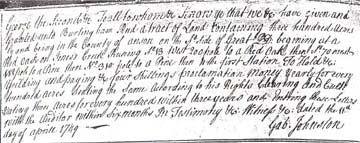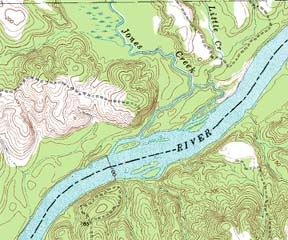
George the Second (symbol) To all to whom (symbol) Know ye that we (symbol) have given unto Burlingham Rud a tract of land containing three hundred acres of land in Anson County on the So. Side of Great Pee Dee beginning at a Red Oak on Jones Creek running So. 13 West 200 poles to a Red Oak then So. 70 West 188 poles to a Pine then No. 310 poles to a Pine then to the first station. To Hold (symbol): Dated the 11th day of April 1749. Gab. JohnstonThis appears to be the warrant that was entered into the land book that authorized the surveyor to complete the survey for Burlingham’s original 300 acre grant.
Source: North Carolina Secretary of State Land Grant Record Book 5, p. 314, Burlingham Reed, File #506
George the Second (symbol) To all to whom (symbol) Know ye that we (symbol) have given and granted unto Burlingham Rud a tract of land containing three hundred acres lying and being in the County of Anson on the So. Side of the Great Pee Dee beginning at a Red Oak on Jones Creek running So. 13 West 200 poles to a Red Oak then So. 70 West 188 poles to a Pine then No. 310 poles to a Pine then to the first station. To Hold (symbol): Yielding and paying (symbol) four shillings proclamation money yearly for every hundred acres. Sealing the same according to his rights. Clearing and cultivating three acres for every hundred within three years and entering these letters with the auditor within six months. In Testimony (symbol): Witness (symbol): dated the 11th day of April 1749. Gab. Johnston(Pictured Above) This appears to be the patent that was issued to Burlingham 1st laying out the details of the tax to be levied on the land and the requirements for cultivation.
Source: North Carolina Secretary of State Land Grant Record Book 10, p. 154, Burlingham Reed, File #563
In 1663 and 1665 Charles II granted to eight men who helped him regain the English throne, an enormous expanse of land in America in which was located present-day North Carolina. Under the two charters, these eight Lords Proprietors received the authority to grant land. These grants from 1663 to 1729 were almost always in the form of headrights.
The Lords Proprietors, absentee landlords, were disappointed that their investment in the Americas did not reap them the wealth they had expected. In 1729 all the proprietors, except Lord Granville, sold their grants back to the Crown. North and South Carolina became two separate royal provinces. The Crown appointed royal governors.
Between 1713 and 1763 North Carolina's population grew because land was available at such low prices. The royal governors were directed to "grant 50 acres free to each settler, and Lord Granville, who held the counties bordering on Virginia, charged only three shillings for 640 acres.
These grants, for 50 acres for each person they brought into NC, were usually based on the passage being paid for by the emigrant applying for the patent. These patents were usually called headrights and there were no fees required of those who qualified for these patents. It was common practice for settlers to sell their headrights entitlement to an assignee. (A person to whom property, rights, or powers are transferred) The rules changed through the years. The Crown continued the headright system used by the Proprietors until about 1752. After that date, purchase patents were the usual form.
The purchase patent way of obtaining land in the Carolinas existed from 1720 -1754. It required settlers to pay fees to cover the cost of the paperwork involved with entering the plot in the records, the warrant, and plat. In 1754 through the early years of NC statehood, this became the only way of acquiring vacant land.
The process involved several steps:
Entries or Applications
A person chose a piece of vacant land, entered a claim or applied for it by describing its features to a government official or entry-taker. The entry-taker would record the description on loose sheets or into bound volumes, depending on the time period. These descriptions show the name of the person seeking the land, a description of the land, the number of acres, the name of adjacent land owners, and the date the entry was made.
Warrants
If, after three months, the person seeking the land received no opposition to his entry by way of legal caveat, the entry taker would convey a warrant to the assigned surveyor. This warrant was the authorization for the surveyor to complete a plat. Sometimes as many as 10 years could pass between entry and warrant.
Plats or Surveys
After receiving the warrant, the surveyor would survey the land and draw a plat map. This map may vary from the land description given in the entry or warrant. The surveyor sent copies of the plat to the land office.
Grants or Patents
After officials received the necessary papers and fees, the new land owner was given the grant document that was his patent to the land.

Without further investigation I can’t decide if this was a headright grant or a purchased patent. After The Crown bought back that part of the Carolinas from the Lord Proprietors in 1729 they continued the headright system until about 1752. After that date, purchase patents were the usual form. And in 1754 through the early years of NC statehood, the purchased patent became the only way of acquiring vacant land.
During my research of the system used to grant land in North Carolina it is said by some that the headright system was seldom used by the Crown and it became increasing difficult to obtain a headright. This was because it became a very popular way to accumulate large tracts of land. The person bringing the settlers into the colony and paying for the patent process was the one who acquired the 50 acre allotment of land, not the person being brought into the colony. The date on Burlingham’s original grant is so close to the time that the system was changing, it’s difficult to know whether he had a headright or purchased a patent by the language in the grant. It’s my understanding the financial requirements (property tax and cultivation requirement) laid out in the grant would have applied in either case.
The reason this is an important issue for us is that if Burlingham acquired his 300 acres as a headright and that headright system was to give 50 acres per person he transported into the colony, then that would indicate he brought in at least 6 people including himself. And that could be two adults and four children, one more than is listed in the Prince Frederick’s Parish baptismal records.

No comments:
Post a Comment